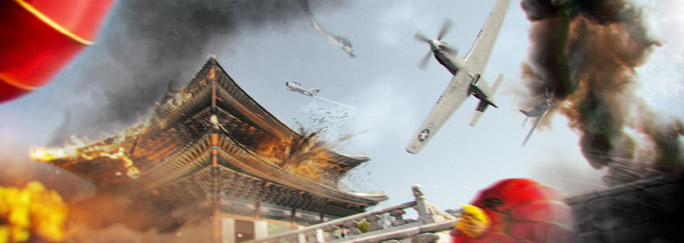-
![LANG-CODE-KEY]() LANG_NAME_KEY
LANG_NAME_KEY

Pilots,
The Korean War is largely remembered amongst aviators for its many duels between the first jet-powered Soviet MiGs and U.S. Sabres. Both representing the pinnacle of aviation technology for their time, the two machines reached legendary status in no small part due to their clashes in the skies over Korea. However, what mustn’t be forgotten is that the conflict also saw extensive use of older, piston-driven aircraft that, albeit less capable, still played an important part in the outcome of the war. Today we want to dedicate a special to all of these propeller-powered warbirds whilst giving you some background on the course of the events that they participated in. Get ready, strap in, and be prepared to be entertained and educated at the same time pilots!
‘Conflict in Korea’ Special | ||
|---|---|---|
|
All offers and missions will be available from Friday 26 June at 07:00 CEST until Monday 29 June at 07:30 CEST (UTC+2). |
||
Double Crew XP for each battle
Remember, experienced Soviet pilots fought with North Korea during the conflict!
50% discount on all Paint Shop items
Whether you want a new coat of paint, an emblem, or an inscription – all beautification items are on sale this weekend!
30% discount on the following planes:
 |
P-51D Mustang |
|||
 |
Chance-Vought F4U-4 Corsair |
|||
 |
Grumman F7F Tigercat |
|||
 |
Lavochkin La-7 |
|||
 |
Yakovlev Yak-9U |
|||
 |
Yakovlev Yak-3 |
|||
 |
Mikoyan-Gurevich I-250 |
|||
 |
Ilyushin IL-10 |
|||
 |
Ilyushin IL-8 |
All of these aircraft flew over North Korea at some point. Let them soar in-game as well, pilots!
Combine the Double Crew XP bonus with our additional Plane XP boost for ultimate progress when finishing our newest special mission this weekend!
Mission 1: East vs. West |
|
|
Goal |
Win a battle and become one of the top 5 experience earners on your team flying the required aircraft. |
|
Reward |
30% extra XP for the battle |
|
Conditions |
|
The end of WWII, and most notably the conclusion of the conflict in the Pacific, left the Korean peninsula divided into two parts along the 38th parallel. While the northern part was controlled by Soviet forces, the southern part went to the U.S. When the country failed to hold unified elections in 1948, the divide between the two parts deepened, leading to the establishment of a Soviet-oriented communist regime in the north and a right-wing western government in the south. Political tensions between the two halves continued until their escalation on 25 June 1950 when North Korea, supplied by the Soviets and supported by China, invaded the south.
21 countries of the newly established United Nations, including the likes of the U.S., the U.K., Turkey, Canada, Australia, France, New Zealand and others, sprang into action to defend South Korea. Their help couldn't have come soon enough, as the North Koreans had surprised the South Korean government and managed to conquer almost the entire peninsula. What ensued was a series of heavy back-and-forth battles during which territories often changed hands in engagements between infantry, tank divisions, naval units and aircraft.
The North-Korean Airforce initially only consisted of left-over Soviet WWII-fighters such as the Yak-9 or La-9. These propeller-driven planes had a tough time competing against the superior P-51D Mustangs, F-80 Shooting Star and F9F Panthers that the UN forces were using. However, everything changed in October 1950 with Stalin's decision to supply North Korea with the newest Soviet invention: the Mikoyan-Gurevich MiG-15. Squads of this legendary jet fighter reigned supreme in the skies over Korea, taking out aircraft after aircraft of their outdated competition. The U.N. forces were forced to largely retire their piston-driven aircraft and replace them with evenly matched F-86 Sabres.
These two historic jet-fighters would go on to clash many times throughout the war, most notably in the northwestern portion of North-Korea which got nicknamed "MiG Alley" by UN pilots. The area gained notoriety for being the first zone in which large-scale jet-vs-jet air battles would take place. Both sides claim to have held air superiority in the region with loss and victory numbers varying heavily depending on the source. There are an estimated 100 pilots between the four involved parties that are said to have become Aces during the conflict which ended on 27 July 1953.
Which side will win when you recreate the conflict in-game, pilots?